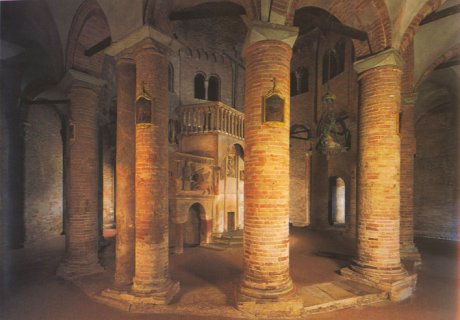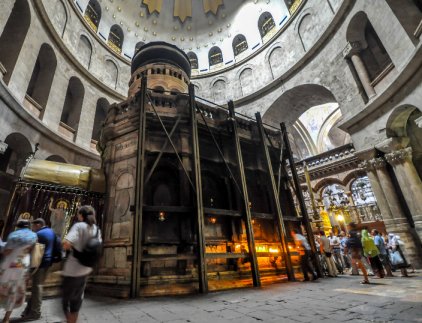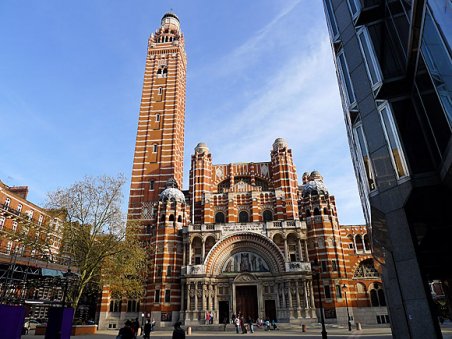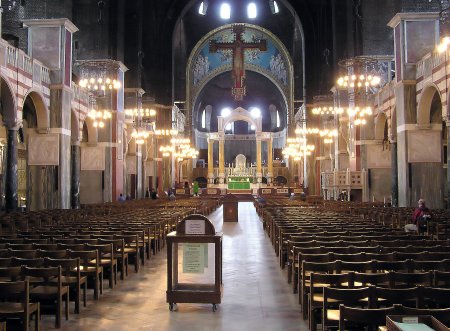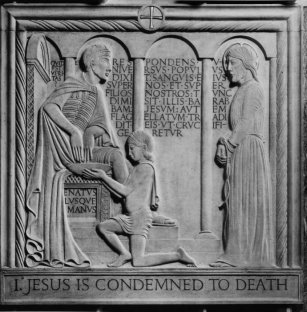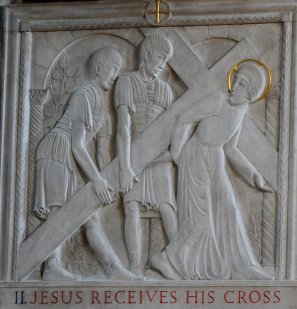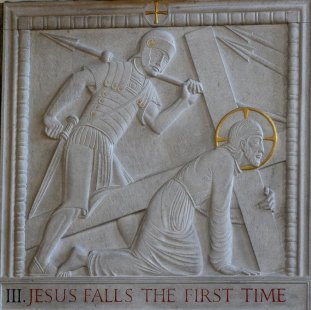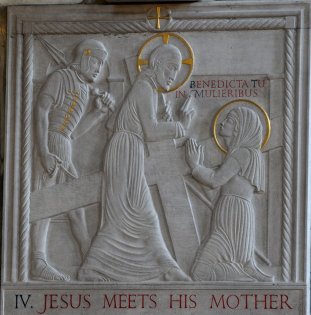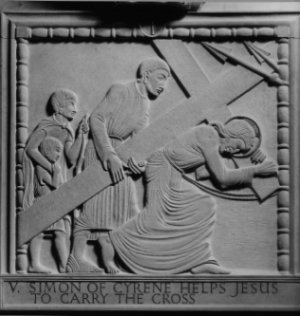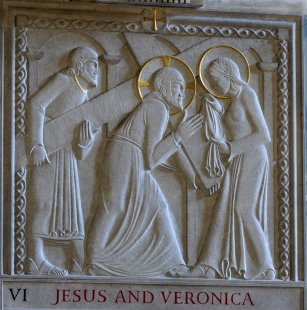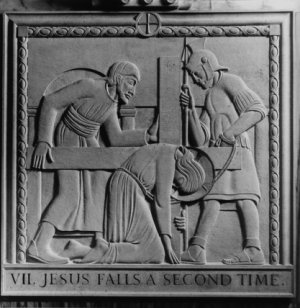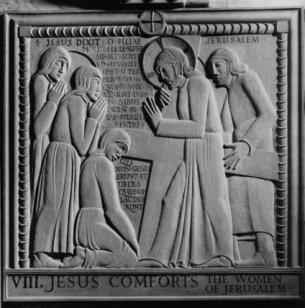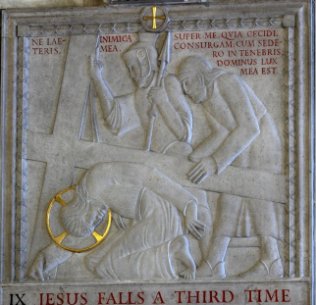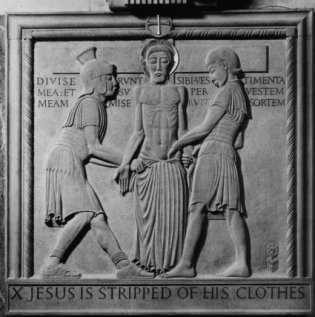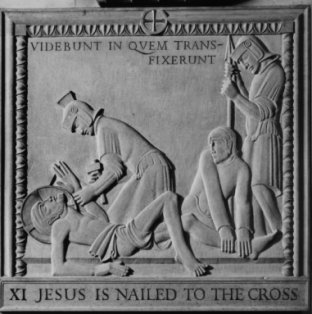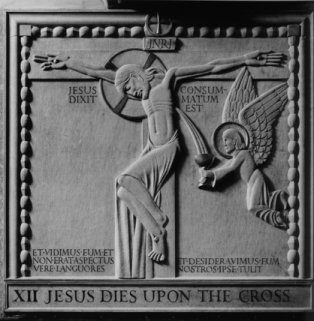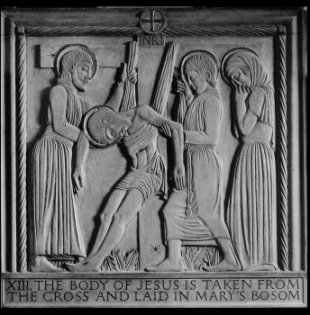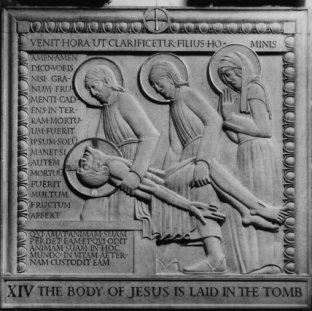|
Via Crucis - the Stations of the Cross |
|||||
Something of a departure on the page - I'm going to focus on a twentieth century work of art, and suggest a musical accompaniment! But first a little background and, predictably, a trip to a favourite city in Italy. The Stations of the Cross is a sequence of usually fourteen images showing the events on Christ's journey with the cross through Jerusalem to Golgotha, the location of the crucifixion outside the city. Enter almost any Catholic church - and some Anglican ones - and you will find the fourteen stations set out round the nave of the church. These would usually be paintings, but can be sculptures or wall plaques. Following the stations around the church can be thought of as a 'virtual pilgrimage' to Jerusalem: perhaps 'spiritual journey' might be more appropriate. Doing that for real was only for a select few in early times. As with so much imagery of the Passion, the Stations of the Cross were developed by Franciscans: they developed them for real in Jerusalem itself. Having said that, the idea of replicating locations in Jerusalem went back even earlier. San Stefano, the complex of churches in Bologna, is traditionally said to have been founded in the fifth century to replicate the sacred sites in Jerusalem. The earliest part of the church, the rotunda of San Sepolchro, (left below) is clearly modelled on the church of the Holy Sepulchre, (right) though the Jerusalem church has been rebuilt many times over the centuries. The tomb in Bologna once contained the relics of St Petronius, founder of the church. |
|||||
|
|
|
||||
So what were the stations? The traditional fourteen are: |
|||||
| 1.Christ
is condemned to death 2.The Cross is laid upon Christ 3.Christ falls the first time 4.Christ meets his mother 5.Simon of Cyrene is made to carry the Cross 6.Veronica wipes the face of Christ 7.Christ falls for the second time |
8.Christ
meets the women of Jerusalem 9.Christ falls the third time 10.Christ is stripped of his garments 11.The Crucifixion: Christ is nailed to the Cross 12.Christ dies on the Cross 13.Christ is taken down from the Cross 14.Christ is laid in the tomb. |
||||
The fact that a number of these do not have biblical authority has caused concern to some, and a new version was introduced by John Paul II in 1991. Poor old Veronica had to go. To keep the number at 14 the sequence started earlier, with the events in Gethsemane. |
|||||
On to some images - and Eric Gill. Westminster Cathedral, the premier Catholic church in England, was completed, at least as far as the building was concerned, at the beginning of the twentieth century. Perhaps bravely, the architect, and the cardinal of the time, Cardinal Bourne, turned to Eric Gill, a young and virtually unknown sculptor, to produce the stations of the Cross. One advantage for them was that he was cheap - he needed to build a reputation and he agreed to produce all fourteen stations for £765. A bargain! Gill's later somewhat eccentric reputation may have put the cardinal off had he known about it at the time! I'll refrain from going into the gory details here - if you must know, look up Eric Gill on Wikipedia. Gill's work had a mixed reception at the time; they were too modern for some and words such as 'hideous', 'cold' and 'pagan' were bandied about. Others were much more impressed. Now, they are regarded as one of the great works of twentieth century art. |
|||||
|
|
|
||||
|
Westminster Cathedral |
|||||
|
|
|
|
|||
|
|
|
|
|||
|
|
|
|
|||
|
|
|
|
|||
|
|
|
||||
| And so
to some music. Via Crucis, by Liszt, has always been a favourite of mine.
It's easy to think of Liszt as a romantic composer, noted for big tunes
and (to a modern taste) a touch of sentimentality. This work is very
different; austere, quite modern sounding, and in my view a good match
for Eric Gill. There are many recordings available. To my ears, organ accompaniment
is essential; piano versions just don't work for me. Right click this
image and choose 'open link in new window', or Go to Youtube and search
for Liszt/Via Crucis - this is a particularly splendid version.
Better still buy the CD! |
|||||
| Update. In October 2015 my wife and I visited Jerusalem, and were able to walk the Via Dolorosa and see the fourteen stations for real. Here is my blog page of the walk. | |||||
